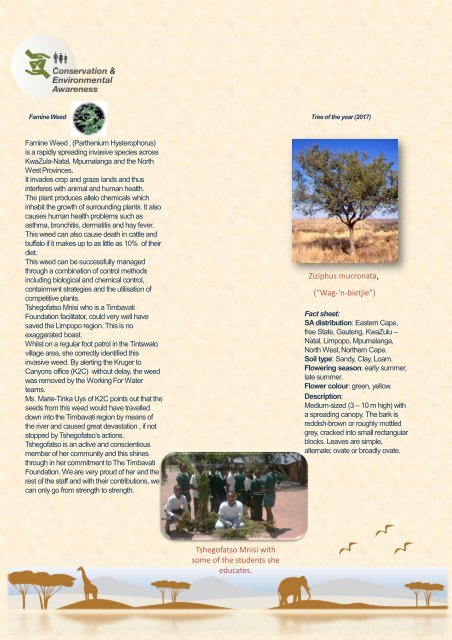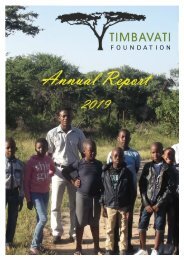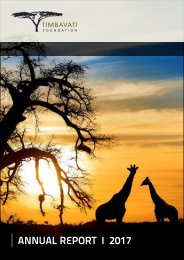Annual Report 2018
You also want an ePaper? Increase the reach of your titles
YUMPU automatically turns print PDFs into web optimized ePapers that Google loves.
Famine Weed<br />
Tree of the year (2017)<br />
Famine Weed , (Parthenium Hysterophorus)<br />
is a rapidly spreading invasive species across<br />
KwaZula-Natal, Mpumalanga and the North<br />
West Provinces.<br />
It invades crop and graze lands and thus<br />
interferes with animal and human health.<br />
The plant produces allelo chemicals which<br />
inhabit the growth of surrounding plants. It also<br />
causes human health problems such as<br />
asthma, bronchitis, dermatitis and hay fever.<br />
This weed can also cause death in cattle and<br />
buffalo if it makes up to as little as 10% of their<br />
diet.<br />
This weed can be successfully managed<br />
through a combination of control methods<br />
including biological and chemical control,<br />
containment strategies and the utilisation of<br />
competitive plants.<br />
Tshegofatso Mnisi who is a Timbavati<br />
Foundation facilitator, could very well have<br />
saved the Limpopo region. This is no<br />
exaggerated boast.<br />
Whilst on a regular foot patrol in the Tintswalo<br />
village area, she correctly identified this<br />
invasive weed. By alerting the Kruger to<br />
Canyons office (K2C) without delay, the weed<br />
was removed by the Working For Water<br />
teams.<br />
Ms. Marie-Tinka Uys of K2C points out that the<br />
seeds from this weed would have travelled<br />
down into the Timbavati region by means of<br />
the river and caused great devastation , if not<br />
stopped by Tshegofatso’s actions.<br />
Tshegofatso is an active and conscientious<br />
member of her community and this shines<br />
through in her commitment to The Timbavati<br />
Foundation. We are very proud of her and the<br />
rest of the staff and with their contributions, we<br />
can only go from strength to strength.<br />
Ziziphus mucronata,<br />
(“Wag-'n-bietjie”)<br />
Fact sheet:<br />
SA distribution: Eastern Cape,<br />
free State, Gauteng, KwaZulu –<br />
Natal, Limpopo, Mpumalanga,<br />
North West, Northern Cape.<br />
Soil type: Sandy, Clay, Loam.<br />
Flowering season: early summer,<br />
late summer.<br />
Flower colour: green, yellow.<br />
Description:<br />
Medium-sized (3 – 10 m high) with<br />
a spreading canopy. The bark is<br />
reddish-brown or roughly mottled<br />
grey, cracked into small rectangular<br />
blocks. Leaves are simple,<br />
alternate; ovate or broadly ovate.<br />
Tshegofatso Mnisi with<br />
some of the students she<br />
educates.




